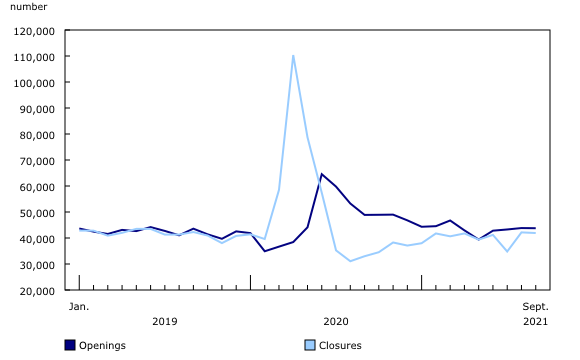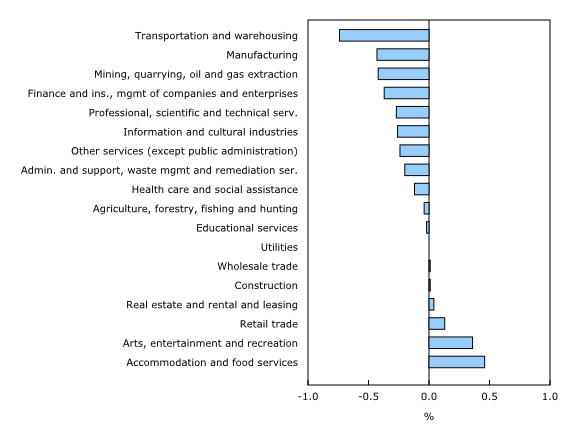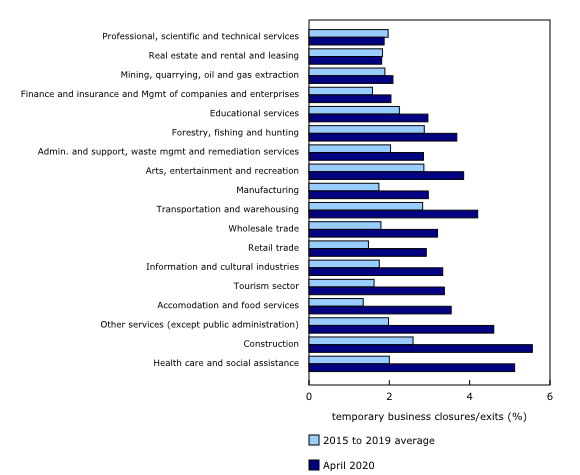Monthly estimates of business openings and closures, September 2021
Archived Content
Information identified as archived is provided for reference, research or recordkeeping purposes. It is not subject to the Government of Canada Web Standards and has not been altered or updated since it was archived. Please "contact us" to request a format other than those available.
Released: 2022-01-05
Business openings were stable in September 2021 (-0.1%; -59) after several months of increases in the number of openings. The change in business closures was also relatively small compared with previous months, decreasing by 0.6% (-252) in September following an increase of 21.2% (+7,370) in August. As a result, the number of active businesses was relatively unchanged since August but remained above February 2020 levels for the fifth consecutive month.
The number of business reopenings rose by 2.5% (+668) in September, but the number of entrants declined by 4.2% (-727). This decline coincides with rising new cases of COVID-19 and the introduction of proof-of-vaccination policies in several regions of Canada including Ontario, British Columbia, Alberta, and Manitoba. The decrease in entrants was driven by Ontario (-5.6%, -385) and British Columbia (-6.0%; -185).
Though the number of entrants was lower from August to September, most regions of Canada also saw a decrease in the number of closings, with the largest decreases occurring in Quebec (-2.0%; -149) and British Columbia (-1.4%; -104). At the national level, however, these decreases were partially offset by a relatively large number of closings in Alberta (+4.4%; +265).
Across sectors, the largest decreases in the number of active businesses were in the transportation and warehousing (-0.7%; -378) and manufacturing (-0.4%, -182) sectors. The number of active businesses in the manufacturing sector had also declined in August (-0.3%; -132), for the first time since May 2020. On the other hand, the number of active businesses continued to increase in accommodation and food services (+0.5%; 277), and in arts, entertainment, and recreation (+0.4%; 49). Nevertheless, the number of active businesses in these industries remain below the pre-pandemic level (February 2020), as these increases brought the number of active businesses in these sectors to 4.2% below and 5.7% below pre-pandemic levels, respectively.
New series on temporary business closures and exits are now available
The experimental series on monthly business openings and closures now includes monthly estimates of temporary business closures and exits (or "permanent closures") at the national level by industry, as well as at the provincial level for the business sector.
Between January 2015 and December 2019, the number of temporary business closures has generally been higher than the number of exits by an average of about 75%, indicating that temporary closures were more common than exits. At the onset of the COVID-19 pandemic, or in April 2020, the ratio of temporary business closures to exits increased, as there were 1.2 times as many temporary business closures (76,119) as there were exits (34,251). Since the onset of the pandemic, the number of exits returned to their historical average relatively quickly, while the number of temporary closures returned more recently.
The pattern observed in the business sector is also observed at the industry level. However, variations are present across industries in terms of the increase in temporary business closures relative to exits early on in the pandemic. For instance, temporary closures were more than 5 times the number of exits in the construction and health care and social assistance sectors in April 2020, compared with 2 to 3 times the average share from 2015 to 2019. A similar increase in the number of temporary closures relative to exits is observed in industries that were heavily impacted by the pandemic, including accommodation and food services and the tourism sector. In contrast, in professional, scientific and technical services, and real estate, rental and leasing, temporary closures as a share of exits remained relatively unchanged in April 2020 compared with the historical average.
Note to readers
Every new month of data leads to a revision of the previously released data due to such factors as the seasonal adjustment process and a new version of the Generic Survey Universe File (or vintage of the Business Register). As such, the estimates may vary compared with a previous release.
Openings are defined as businesses with employment in the current month and no employment in the previous month, while closures are defined as businesses that had employment in the previous month, but no employment in the current month. Continuing businesses are those that have employees in both months, and the active population in any given month is the number of opening and continuing businesses in that month. Reopening businesses are defined as opening businesses that were also active in a previous month (that is, they closed in a given month and had positive employment in a subsequent month). In contrast, entrants are opening businesses that were not active in a previous month.
The definition of exits is based on the Longitudinal Employment Analysis Program (LEAP) annual exits. Because the LEAP definition can require up to 24 months of data to be counted as an exit, projections of exits using predicted growth rates are implemented using a regression model of exits on closures of more than six months. As a result, there are no published exits in the last six months. A temporary business closure is the difference between closures and exits. For more information on this new series, a methodological paper will be published in the January Economic and Social Reports.
A business is defined as an enterprise operating in a particular geography and industry.
The vast majority of businesses operate in one industry and one location or geography. For these businesses, in the monthly estimates of openings and closures, they will be counted once at the national/provincial level. For example, a retailer in Windsor, Ontario, will be counted as an active business in the Ontario estimates and once in the national estimates.
Some businesses can have multiple operations, and these can be in different industries and geographies. For such businesses, in the monthly estimates of openings and closures, they can be counted more than once because they are active in multiple industries or geographies. For example, if a retailer has operations in both Alberta and Ontario, it will be counted as an active business in both provinces, but only once at the national level because it represents only one active firm. Similarly, a firm with retail and wholesale operations will be counted in both industries when individual industries are examined. However, when the business sector is examined, the firm counts only once because at that level it represents one firm active in the business sector.
Contact information
For more information, or to enquire about the concepts, methods or data quality of this release, contact us (toll-free 1-800-263-1136; 514-283-8300; infostats@statcan.gc.ca) or Media Relations (statcan.mediahotline-ligneinfomedias.statcan@statcan.gc.ca).
- Date modified:





